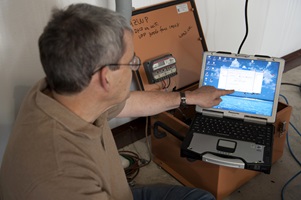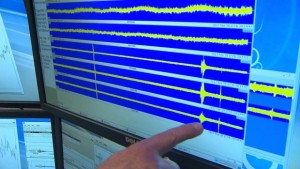Dedman College Faculty Searching for a Reason Behind the Shaking
Few North Texans expect to experience earthquakes, so the recent spate of seismic activity has left many asking questions about the source of the rattling. Heather DeShon, Matthew Hornbach, Beatrice Magnani, and Brian Stump, faculty in Dedman College’s Huffington Department of Earth Sciences, have become the leading experts for the seismologic activity within North Texas. Seven graduate students, four undergraduates, two summer undergraduate interns from other Texas universities, and a Lake Highlands High School student, in addition to numerous staff, have been involved in fieldwork and data analysis—making this a true team effort.
 Since 2008, North Texas has experienced over 180 felt earthquakes; the largest earthquake was the May 2015 magnitude 4.0 Venus, Texas, event. The SMU seismology team is leading the way in earthquake studies by operating a network of 30+ seismographs in the DFW area to improve earthquake detection and conducting modeling to determine cause. The project is funded through SMU, the Institute for the Study of Earth and Man (ISEM), and federal and state funds, including a $120,000 cooperative agreement with U.S. Geological Survey.
Since 2008, North Texas has experienced over 180 felt earthquakes; the largest earthquake was the May 2015 magnitude 4.0 Venus, Texas, event. The SMU seismology team is leading the way in earthquake studies by operating a network of 30+ seismographs in the DFW area to improve earthquake detection and conducting modeling to determine cause. The project is funded through SMU, the Institute for the Study of Earth and Man (ISEM), and federal and state funds, including a $120,000 cooperative agreement with U.S. Geological Survey.
Although many citizens believe that these earthquakes are due to fracking, the SMU work suggests that the earthquakes are not directly related to fracking, but instead to the disposal of wastewater fluids accompanying oil and gas production, which can result in underground pressure changes. The research group notes that there are numerous natural fault lines in the area, including some that extend from Irving into West Dallas where the current activity closest to SMU is occurring. Published SMU research to date indicates that a possible factor in causing North Texas earthquakes at the DFW airport, Cleburne, and Azle, may be the rapid removal or injection of large volumes of wastewater. Studies regarding cause for the Irving/Dallas and Venus earthquake sequences are ongoing.
The team’s most recent study was published in Nature Communications this April and focused on the 2013-2014 Azle earthquake sequence. The work presented models and data that link the earthquakes to a combination of oil and gas extraction and wastewater injection. Natural causes that were ruled out included ground water changes due to the drought and local lake level fluctuations near the earthquakes. The paper provided suggestions to better understand linkages between earthquakes and oil and gas activity, including closer monitoring of the wells and increased access to geologic information held by industry. The yearlong study was a collaborative project including a total of eleven researchers from SMU, the University of Texas at Austin, and the U.S. Geological Survey. 
The team continues to work on improving the understanding of the possible causes of the earthquakes in order to improve hazard estimates for the region and understand how, or if, mitigation is possible. Predicting the next North Texas earthquake is not possible, but the SMU seismology team is hard at work educating North Texans about earthquakes and preparedness and updating city and state officials about North Texas earthquakes.